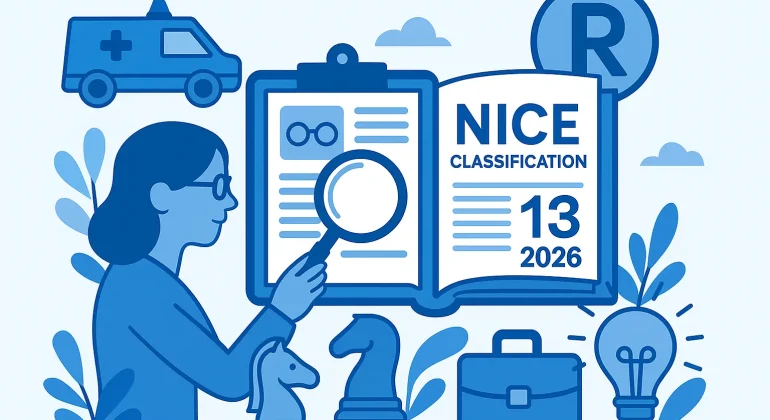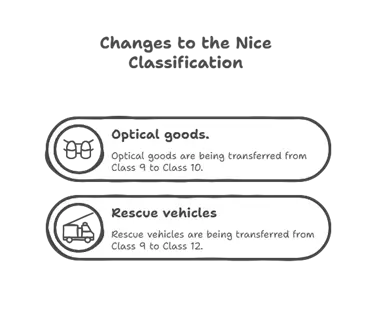Sommaire
Introduction
The Nice Classification (NCL) is the international system used to classify goods and services for trademark registration, managed by WIPO. NCL (13 2026), effective from January 1, 2026, introduces several structural changes that impact filing strategies, portfolio management, and trademark protection. Below is our comprehensive legal and operational guide.
Understanding the Nice Classification
Established under the Nice Agreement (1957), the Nice Classification (NCL) serves as the international reference framework to categorize goods and services into 45 classes: 34 for goods and 11 for services.
It ensures global harmonization and facilitates prior rights searches, oppositions, and registration procedures. Accurate classification is essential for securing legal protection and avoiding office refusals. Each edition is updated annually to reflect market and technological developments.
Trademark applications are assessed based on the version in force at the time of filing. However, discrepancies in wording can lead to observations during examination.
What’s New in NCL (13 2026)
Published in advance by WIPO, the NCL (13 2026) introduces major changes. Optical products (glasses, lenses, accessories) are transferred from class 9 to class 10, better reflecting their medical and therapeutic use. Class 9 now retains electronic and technological products, such as virtual and augmented reality glasses. As for class 10, it now includes corrective glasses, sunglasses, contact lenses, and associated accessories (cases, cleaning cloths, etc.).
Emergency and rescue vehicles (fire trucks, lifeboats) are transferred from class 9 to class 12, confirming their nature as vehicles.
Impact on Related Classes
- Class 35: Retail of glasses and optical accessories, including online sales.
- Class 44: Medical services related to optics, such as optometric consultations and glasses fitting.
This new edition also includes refinements and deletions to clarify terminology and reduce class overlaps, particularly in areas such as connected health and digital equipment.
Applications filed at the end of 2025 may be subject to close scrutiny if the wording does not align with NCL (13 2026). Portfolios covering optics, medical devices, or vehicles should therefore be reassessed to prevent protection gaps.
Impact on Existing Trademarks
The introduction of NCL (13 2026) will have a significant impact on trademarks that are already registered. While applications filed before 2026 will still be examined according to NCL (12 2025), companies must reassess their portfolios to identify trademarks affected by the class changes, particularly those related to optical products and emergency vehicles.
Outdated or incorrectly classified terms may lead to protection gaps. Therefore, it is essential to update existing registrations to ensure continued protection and avoid any ambiguity in the interpretation of rights.
Points of Attention for Applicants
Managing the transition to NCL (13 2026) is crucial. Applications filed before 2026 will continue to be examined under NCL (12 2025), while those filed from January 1, 2026 must strictly comply with NCL (13 2026).
To avoid delays, observations, or additional costs, it is recommended to conduct a portfolio audit to identify risks of double protection or outdated terms, as well as to update license or coexistence agreements in line with the new classes.
terminology, or vulnerabilities, and to adjust license or coexistence agreements according to the new class allocations.
Strategic Considerations for Trademark Portfolios
Anticipating and adapting to this new edition is crucial. Updating your filing strategy now, particularly in the affected sectors, will help secure your rights. Filing before the end of 2025 might be advantageous if the current classification offers broader protection.
In certain cases, complementary or defensive filings will be necessary if class transfers result in coverage gaps. To maintain enforceability, internal models and management tools should be updated, and third-party filings in newly impacted classes should be closely monitored.
Directive 2004/48/EC and relevant national laws remain key legal tools for enforcing reclassified rights.
Conclusion
The transition to NCL (13 2026) marks a pivotal moment for trademark portfolio strategy. Companies must anticipate class transfers, verify their current filings, and adjust their practices to maintain robust protection.
Dreyfus Law Firm assists its clients in managing complex intellectual property matters, offering tailored legal advice and end-to-end operational support to ensure comprehensive protection of intellectual assets.
The Dreyfus Law Firm partners with a global network of IP-specialized lawyers.
Follow us on social media!
Nathalie Dreyfus, with the support of the entire Dreyfus team
FAQ
1. What is the Nice Classification?
It is the international system that organizes goods and services into 45 classes for trademark registration.
2. When will NCL (13 2026) take effect?
It will apply as of January 1, 2026.
3. What happens to pending applications?
They will be examined under NCL 12, but any discrepancies in wording may result in office actions.
4. What are the main changes?
The transfer of optical goods to Class 10 and emergency vehicles to Class 12.
5. Should you audit your trademark portfolio?
Yes, to ensure compliance and avoid protection gaps.
6. Can trademarks still be filed under NCL 12?
Yes, until December 31, 2025.
7. Are license agreements impacted?
Yes, agreements that reference specific classes should be updated.
8. Where can I find NCL (13)?
On WIPO’s NCLPub website, available in English and French.


